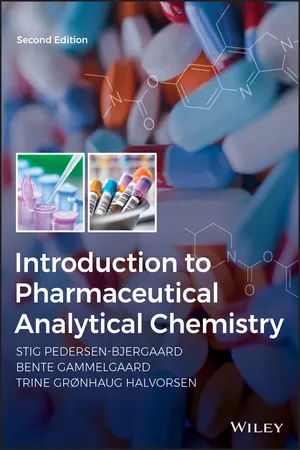
Introduction to Pharmaceutical Analytical Chemistry
- English
- ePUB (mobile friendly)
- Available on iOS & Android
Introduction to Pharmaceutical Analytical Chemistry
About This Book
The definitive textbook on the chemical analysis of pharmaceutical drugs – fully revised and updated
Introduction to Pharmaceutical Analytical Chemistry enables students to gain fundamental knowledge of the vital concepts, techniques and applications of the chemical analysis of pharmaceutical ingredients, final pharmaceutical products and drug substances in biological fluids. A unique emphasis on pharmaceutical laboratory practices, such as sample preparation and separation techniques, provides an efficient and practical educational framework for undergraduate studies in areas such as pharmaceutical sciences, analytical chemistry and forensic analysis. Suitable for foundational courses, this essential undergraduate text introduces the common analytical methods used in quantitative and qualitative chemical analysis of pharmaceuticals.
This extensively revised second edition includes a new chapter on chemical analysis of biopharmaceuticals, which includes discussions on identification, purity testing and assay of peptide and protein-based formulations. Also new to this edition are improved colour illustrations and tables, a streamlined chapter structure and text revised for increased clarity and comprehension.
- Introduces the fundamental concepts of pharmaceutical analytical chemistry and statistics
- Presents a systematic investigation of pharmaceutical applications absent from other textbooks on the subject
- Examines various analytical techniques commonly used in pharmaceutical laboratories
- Provides practice problems, up-to-date practical examples and detailed illustrations
- Includes updated content aligned with the current European and United States Pharmacopeia regulations and guidelines
Covering the analytical techniques and concepts necessary for pharmaceutical analytical chemistry, Introduction to Pharmaceutical Analytical Chemistry is ideally suited for students of chemical and pharmaceutical sciences as well as analytical chemists transitioning into the field of pharmaceutical analytical chemistry.
Frequently asked questions
Information
1
Introduction to Pharmaceutical Analytical Chemistry
- 1.1 Introduction
- 1.2 Pharmaceutical Analytical Chemistry
- 1.2.1 A Brief Definition
- 1.2.2 Manufacture of Pharmaceuticals
- 1.2.3 Development of New Drugs
- 1.2.4 Use of Pharmaceuticals
- 1.3 This Textbook
1.1 Introduction

- Ensure that the dosage form has a shape and size that is easy to use for the patient.
- Ensure that the API is released and delivered to the patient in the correct amount.
- Ensure that the pharmaceutical preparation has an acceptable stability.
- Ensure that the pharmaceutical preparation does not have an unpleasant taste or odour.
- Facilitate production of the pharmaceutical preparation.
| Content | Amount (mg) | Function |
| Tablet (mass 285 mg) | ||
| Paracetamol | 250 | Active ingredient |
| Hydroxypropyl cellulose | Binder | |
| Maize starch | Disintegrant | |
| Talcum | Glidant | |
| Magnesium stearate | Lubricant | |
| Syrup (volume 1 mL) | ||
| Paracetamol | 24 | Active ingredient |
| Sorbitol | Sweetener | |
| Glycerol | Sweetener | |
| Polyvinylpyrrolidone | Thickening agent | |
| Saccharine sodium salt | Sweetener | |
| Methylparaben | Preservative | |
| Ethylparaben | Preservative | |
| Propylparaben | Preservative | |
| Sodium metabisulfite | Antioxidant | |
| Citric acid | pH regulator | |
| Sodium citrate | pH regulator | |
| Strawberry aroma | Flavouring agent | |
| Water | Solvent | |
Table of contents
- Table of Contents
- Preface to the Second Edition
- Abbreviations
- Symbols and Units
- 1 Introduction to Pharmaceutical Analytical Chemistry
- 2 Marketing Authorizations, Pharmaceutical Manufacturing, and International Pharmacopoeias
- 3 Fundamentals of Bases, Acids, Solubility, Polarity, Partition, and Stereochemistry
- 4 Fundamentals of Pharmaceutical Analytical Chemistry
- 5 Titration
- 6 Introduction to Spectroscopic Methods
- 7 UV‐Vis Spectrophotometry
- 8 IR Spectrophotometry
- 9 Atomic Spectrometry
- 10 Introduction to Chromatography
- 11 Separation Principles in Liquid Chromatography
- 12 High Performance Liquid Chromatography
- 13 Gas Chromatography
- 14 Electrophoretic Methods
- 15 Mass Spectrometry
- 16 Sample Preparation
- 17 Quality of Analytical Data and Validation
- 18 Chemical Analysis of Pharmaceutical Ingredients
- 19 Chemical Analysis of Pharmaceutical Preparations
- 20 Bioanalysis Chemical Analysis of Pharmaceuticals in Biological Fluids
- 21 Chemical Analysis of Biopharmaceuticals
- Index
- End User License Agreement